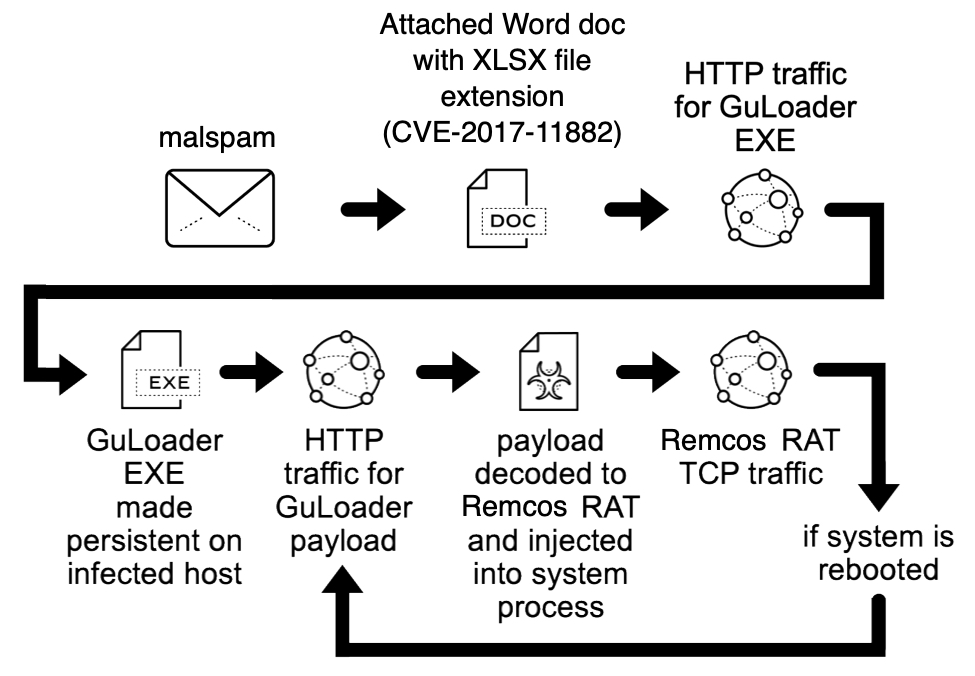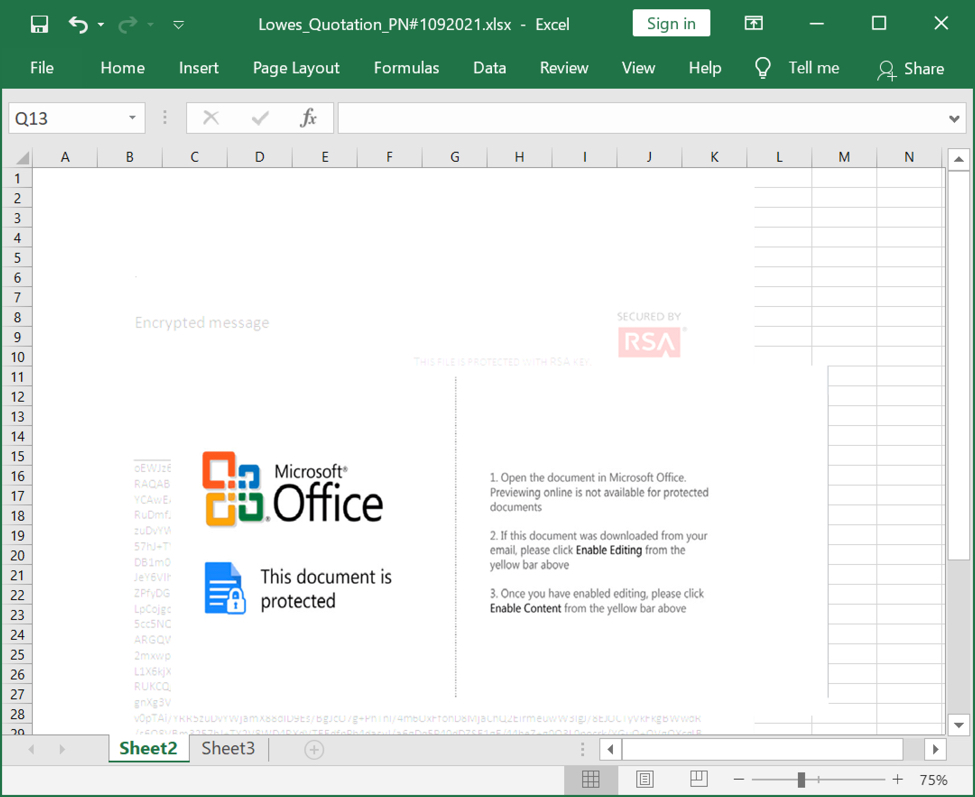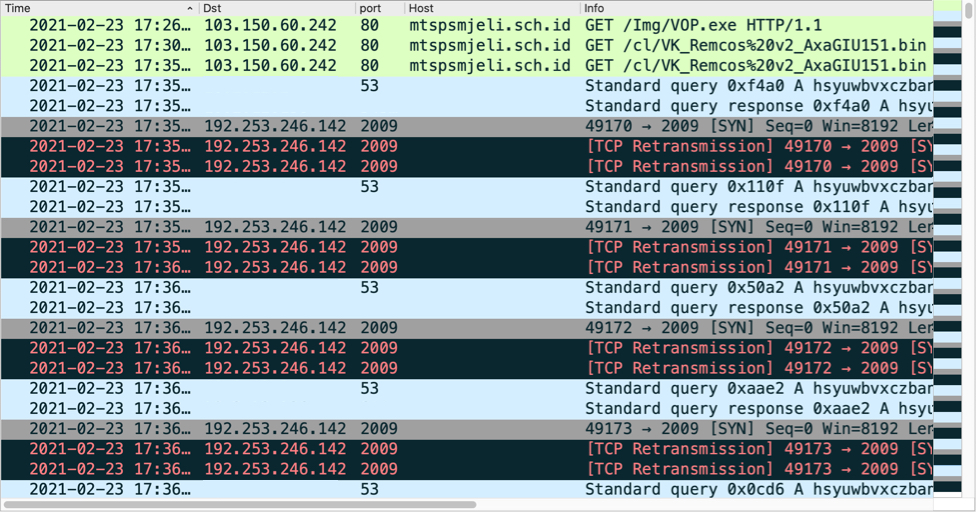Malspam pushes GuLoader for Remcos RAT
Introduction
Malicious spam (malspam) pushing GuLoader malware has been around for over a year now. GuLoader is a file downloader first observed in December 2019, and it has been used to distribute a wide variety of malware, especially malware based on remote administration tools (RATs). I wrote a blog last year examining malspam using GuLoader for Netwire RAT. And GuLoader activity has continued since then.
Today's diary reviews a case of malspam pushing GuLoader for Remcos RAT on Tuesday 2021-02-23.

Shown above: Flow chart for the Remcos RAT infection reviewed in today's diary.
The malspam

Shown above: Screenshot of the malspam.
The malspam is supposedly from someone in Lowes from Canada. Below are some email headers associated with this message.
Date: 23 Feb 2021 07:18:05 +0100
From: CHIRAG MARCUS <[email protected]>
Subject: New Quotation 2021
Message-ID: <[email protected]>
As noted above, the sender is supposedly from lowes-ca.org, but this site is not associated with Lowes. That domain has an open directory for its web server, and it seems like it's being used for malicious purposes.

Shown above: Lowes-ca.org when viewed in a web browser.
The attachment
I opened the attachment in my lab, but I was on a Windows 10 host running a recent version of Microsoft Office. Initially, I didn't realize this was a document with an exploit targeting CVE-2017-11882. I had to switch to an older Windows 7 host to get an infection.

Shown above: Screenshot of the attachment opened in Excel.
The infection traffic
Infection traffic was typical for what I've seen with previous GuLoader infections for some sort of RAT-based malware. In this case, the infected Windows host was unable to establish a TCP connection with the server used by this sample for Remcos RAT.

Shown above: Traffic from the infection filtered in Wireshark.
Forensics on the infected Windows host
The infected Windows host had GuLoader persistent on the infected host using a registry update. When rebooted, the GuLoader sample again retrieved the encoded binary for Remcos RAT.

Shown above: GuLoader for Remcos RAT persistent on the infected Windows host.
Indicators of Compromise (IOCs)
Associated malware:
SHA256 hash: 21c4c697c6cba3d1d7f5ae5d768bf0c1d716eccc4479b338f2cf1336cf06b8ad
- File size: 2,231,808 bytes
- File name: Lowes_Quotation_PN#1092021.xlsx
- File description: Email attachment, Word doc with exploit for CVE-2017-11882
SHA256 hash: 6141efb6f1598e2205806c5a788e61c489440dfc942984ee1688bb68ad0f18df
- File size: 106,496 bytes
- File location: hxxp://mtspsmjeli.sch[.]id/Img/VOP.exe
- File location: C:\Users\[username]\AppData\Roaming\win.exe
- File description: Windows EXE, GUI Loader for Remcos RAT
Infection traffic:
GuLoader EXE retrieved through CVE-2017-11882 exploit:
- 103.150.60[.]242 port 80 - mtspsmjeli.sch[.]id - GET /Img/VOP.exe
GuLoader retrieves encoded data for Remcos RAT:
- 103.150.60[.]242 port 80 - mtspsmjeli.sch[.]id - GET /cl/VK_Remcos%20v2_AxaGIU151.bin
Remcos RAT post-infection traffic:
- 192.253.246[.]142 port 2009 - hsyuwbvxczbansmloiujdhsbnbcgywqauaghxvz.ydns[.]eu - attempted TCP connections
Final words
We continue to see new malware samples using exploits based on CVE-2017-11882 in the wild. This vulnerability is over 3 years old, and exploits targeting it are not effective against the most recent versions of Microsoft Windows and Office. The only reason we continue to see these new samples is because distributing exploits based on CVE-2017-11882 remains profitable. That means a substantial number of people still use outdated versions of Microsoft Office and/or Windows that are not properly patched or updated.
GuLoader has been a relatively a constant presence in our threat landscape since it was discovered in December 2019, so I expect we'll also continue to see new samples for various RAT-based malware in the weeks and months ahead.
---
Brad Duncan
brad [at] malware-traffic-analysis.net


Comments